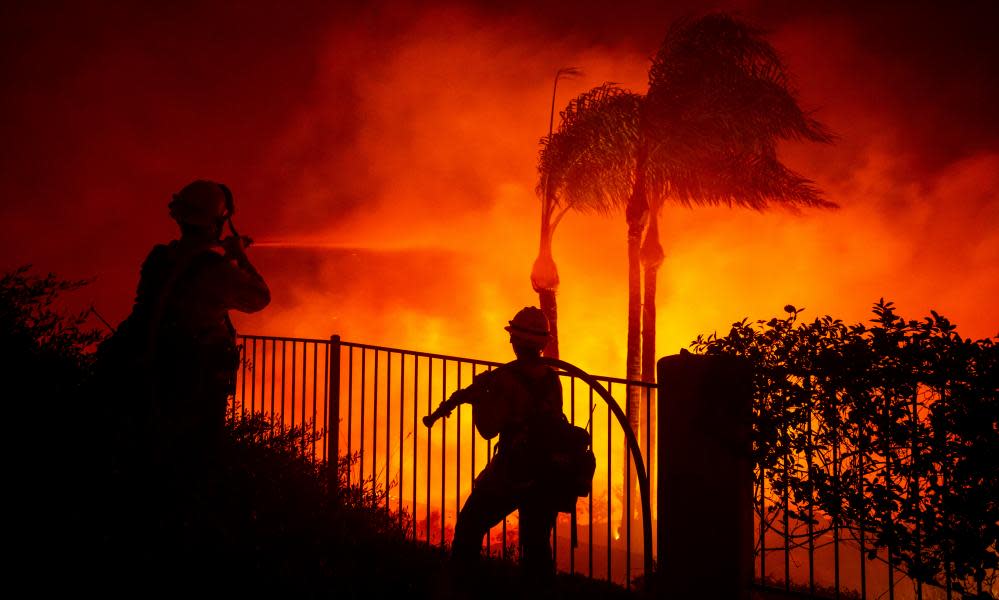Southern California fires: extreme weather stokes two fierce blazes

California battled another round of dangerous fire weather on Tuesday as crews fought a pair of fast-moving blazes in the south that critically injured two firefighters and left more than 100,000 under evacuation orders.
“Hurricane-level winds” combined with low humidity led to the sparking of 42 wildfires throughout the state in the past 24 hours, said Gavin Newsom, California’s governor. In Orange county, two blazes that ignited Monday, the Silverado and the Blue Ridge fires, quickly took hold and grew amid wind gusts of up to 88mph.
“In a year of extremes, as I’ve said often, the hots are getting hotter and the dries are getting drier,” Newsom said. “The winds are also whipping up.”
Two firefighters, one 26 and the other 31, were critically injured while battling the Silverado fire near Irvine, according to the county’s fire authority, which did not provide details on how the injuries occurred. They each suffered second- and third-degree burns over more than 50% of their bodies and were intubated at a hospital, officials said.
Related: Can California’s top wine region survive the era of megafire?
The Silverado fire prompted evacuation orders for more than 20,000 homes in the area of Irvine, while the Blue Ridge fire, which doubled in size overnight, forced evacuation orders a few miles north in the Yorba Linda area. In total, more than 100,000 people were ordered to evacuate, with 90,710 currently evacuated, Newsom said.
One home was reported damaged.
Diablo winds in the north and Santa Ana winds in the south are typical for this time of year, but officials have described this wind event as particularly fierce. Wind gusts reached 96mph in the San Gabriel mountains north of Los Angeles and 140mph in the Sierra Nevada south of Lake Tahoe on Monday.
A red-flag warning of extreme fire danger remained in effect into Tuesday morning in the Santa Cruz Mountains and some coastal and valley areas, with warnings extending into Tuesday evening for some higher elevations in the San Francisco Bay Area. A red-flag warning was extended for parts of southern California into the evening, with the National Weather Service warning that though the Santa Ana winds have weakened from Monday, they “remain gusty over much of the wind-prone area of Los Angeles and Ventura counties”.
Forecasts predicted fierce Santa Ana winds up to 50-80mph (80-129km/h) at times over much of southern California, with some of the strongest gusts howling through Orange county. Winds were back on Tuesday morning, although not to the earlier extremes.
Meanwhile, southern California’s was experiencing some of the worst air quality in the country as a result of the fires. The west coast spent much of the summer blanketed under smoke-choked skies, which have prompted spikes in hospitalizations.
The easing of winds allowed the utility Pacific Gas & Electric to begin restoring power after the largest of five safety shutoffs this year. At its peak, PG&E blacked out about 345,000 customers, an estimated 1 million people, in 34 counties.
The Red Flag Warnings for the lower elevations in the Bay Area as well as Santa Cruz Mtns have been allowed to expire. But the Red Flag Warning for the North Bay Mtns and East Bay Hills continues until 5 pm Tuesday. We've also adjusted our expected winds. Stay Safe! pic.twitter.com/ID7Dd7PGk3
— NWS Bay Area (@NWSBayArea) October 26, 2020
Southern California Edison reported to the state’s Public Utilities Commission that it was investigating whether its equipment might have sparked the blaze in Irvine. The utility said a wire that lashed a telecommunications line to a supporting cable may have struck a 12,000-volt SCE conducting line above it.
SCE was among utilities that cut power to customers to prevent equipment from being knocked down or fouled by debris in the winds and sparking wildfires.
SCE cut power to about 38,000 homes and businesses, although it restored some power by Monday night.
The winds were so strong that firefighters had to ground their aircraft for much of the day in Irvine, though they got back up by late Monday afternoon and continued their work into the night.
Pat McGrath, 78, of Irvine, went to a shelter after a stranger pounded on her door on Monday as she made breakfast. The stranger told her about the evacuation orders.
“I just panicked. I started crying,” McGrath, who has no family on the west coast, told the Los Angeles Times. “I’m cold, I’m hungry, I’m stressed and I don’t know what to do.”
Scientists have said climate change has made California much drier, meaning trees and other plants are more flammable. October and November are traditionally the worst months for fires, but already this year 8,600 wildfires in the state have scorched a record 6,400 square miles (16,600 sq km) and destroyed about 9,200 homes, businesses and other buildings. More than 30 people have been killed in the fires.
Many of this year’s devastating fires were started by thousands of dry lightning strikes, but some remain under investigation for potential electrical causes. While the biggest fires in California have been fully or significantly contained, more than 5,000 firefighters remain committed to 20 blazes, including 14 major incidents, state fire officials said.
“The conditions are very, very unsafe,“ said Mark Quinlan, PG&E’s incident commander, about the weather early this week.

